Available-Maneuvering-Margins-Based Ship Collision Alert System
Abstract
1. Introduction
2. Related Work
3. Methodology
3.1. Conceptual Framework
3.2. Methods Development
3.2.1. Collision Candidate Detection
3.2.2. Determination of Timing for Evasive Maneuvers
3.2.3. Collision Alert Level Quantification
4. Case Study
4.1. Ship Pair Encounter Scenarios
4.1.1. Scenario 1
4.1.2. Scenario 2
4.2. Multi-Vessel Encounter Scenario
4.3. Remarks
5. Discussion and Conclusions
Author Contributions
Funding
Institutional Review Board Statement
Informed Consent Statement
Data Availability Statement
Acknowledgments
Conflicts of Interest
References
- Valdez Banda, O.A.; Goerlandt, F.; Montewka, J.; Kujala, P. Winter navigation at the Baltic Sea: An analysis of accidents occurred during winters 2002–2003 & 2009–2013. In Safety and Reliability: Methodology and Applications; CRC Press: Leiden, The Netherlands, 2014; p. 83. [Google Scholar]
- EMSA. Annual Overview of Marine Casualties and Incidents. European Maritime Safety Agency, 2021. Available online: https://emsa.europa.eu/accident-investigation-publications/annual-overview.html (accessed on 10 August 2022).
- Gil, M.; Kozioł, P.; Wróbel, K.; Montewka, J. Know your safety indicator—A determination of merchant vessels Bow Crossing Range based on big data analytics. Reliab. Eng. Syst. Saf. 2022, 220, 108311. [Google Scholar] [CrossRef]
- Zhang, W.; Zou, Z.; Wang, J.; Du, L. Multi-ship following operation in ice-covered waters with consideration of inter-ship communication. Ocean. Eng. 2020, 210, 107545. [Google Scholar] [CrossRef]
- Zhang, M.; Conti, F.; Le Sourne, H.; Vassalos, D.; Kujala, P.; Lindroth, D.; Hirdaris, S. A method for the direct assessment of ship collision damage and flooding risk in real conditions. Ocean. Eng. 2021, 237, 109605. [Google Scholar] [CrossRef]
- Baldauf, M.; Benedict, K.; Fischer, S.; Motz, F.; Schröder-Hinrichs, J.U. Collision avoidance systems in air and maritime traffic. Proc. Inst. Mech. Eng. Part O J. Risk Reliab. 2011, 225, 333–343. [Google Scholar] [CrossRef]
- Simsir, U.; Amasyalı, M.F.; Bal, M.; Çelebi, U.B.; Ertugrul, S. Decision support system for collision avoidance of vessels. Appl. Soft Comput. 2014, 25, 369–378. [Google Scholar] [CrossRef]
- Goerlandt, F.; Montewka, J.; Kuzmin, V.; Kujala, P. A risk-informed ship collision alert system: Framework and application. Saf. Sci. 2015, 77, 182–204. [Google Scholar] [CrossRef]
- Szlapczynski, R.; Szlapczynska, J. A framework of a ship domain-based collision alert system. In Marine Navigation; CRC Press: Boca Raton, FL, USA, 2017; pp. 183–189. [Google Scholar]
- Szlapczynski, R.; Szlapczynska, J. A ship domain-based model of collision risk for near-miss detection and Collision Alert Systems. Reliab. Eng. Syst. Saf. 2021, 214, 107766. [Google Scholar] [CrossRef]
- Wang, X.; Liu, Z.; Cai, Y. The ship maneuverability based collision avoidance dynamic support system in close-quarters situation. Ocean. Eng. 2017, 146, 486–497. [Google Scholar] [CrossRef]
- Wu, B.; Yip, T.L.; Yan, X.; Soares, C.G. Fuzzy logic based approach for ship-bridge collision alert system. Ocean. Eng. 2019, 187, 106152. [Google Scholar] [CrossRef]
- Gil, M.; Wróbel, K.; Montewka, J.; Goerlandt, F. A bibliometric analysis and systematic review of shipboard Decision Support Systems for accident prevention. Saf. Sci. 2020, 128, 104717. [Google Scholar] [CrossRef]
- Du, L.; Banda, O.A.V.; Goerlandt, F.; Huang, Y.; Kujala, P. A COLREG-compliant ship collision alert system for stand-on vessels. Ocean. Eng. 2020, 218, 107866. [Google Scholar] [CrossRef]
- Yoo, Y.; Lee, J.S. Collision Risk Assessment Support System for MASS RO and VTSO Support in Multi-Ship Environment of Vessel Traffic Service Area. J. Mar. Sci. Eng. 2021, 9, 1143. [Google Scholar] [CrossRef]
- Baldauf, M.; Mehdi, R.; Fischer, S.; Gluch, M. A perfect warning to avoid collisions at sea? Zesz. Nauk. Akad. Mor. W Szczec. 2017, 49, 53–64. [Google Scholar]
- Mestl, T.; Tallakstad, K.T.; Castberg, R. Identifying and analyzing safety critical maneuvers from high resolution AIS data. TransNav Int. J. Mar. Navig. Saf. Sea Transp. 2016, 10, 69–77. [Google Scholar] [CrossRef][Green Version]
- Huang, Y.; van Gelder, P. Measuring ship collision risk in a dense traffic environment. TransNav Int. J. Mar. Navig. Saf. Sea Transp. 2019, 13, 737–744. [Google Scholar] [CrossRef]
- Du, L.; Valdez Banda, O.A.; Goerlandt, F.; Kujala, P.; Zhang, W. Improving Near Miss Detection in Maritime Traffic in the Northern Baltic Sea from AIS Data. J. Mar. Sci. Eng. 2021, 9, 180. [Google Scholar] [CrossRef]
- Sui, Z.; Wen, Y.; Huang, Y.; Zhou, C.; Du, L.; Piera, M.A. Node importance evaluation in marine traffic situation complex network for intelligent maritime supervision. Ocean. Eng. 2022, 247, 110742. [Google Scholar] [CrossRef]
- Zhang, M.; Zhang, D.; Fu, S.; Kujala, P.; Hirdaris, S. A Predictive Analytics Method for Maritime Traffic Flow Complexity Estimation in Inland Waterways. Reliab. Eng. Syst. Saf. 2022, 220, 108317. [Google Scholar] [CrossRef]
- Zhuo, Y.; Tang, T. An intelligent decision support system to ship anti-collision in multi-ship encounter. In Proceedings of the 2008 7th World Congress on Intelligent Control and Automation, Chongqing, China, 25–27 June 2008; pp. 1066–1071. [Google Scholar]
- Montewka, J.; Hinz, T.; Kujala, P.; Matusiak, J. Probability modelling of vessel collisions. Reliab. Eng. Syst. Saf. 2010, 95, 573–589. [Google Scholar] [CrossRef]
- Gil, M. A concept of critical safety area applicable for an obstacle-avoidance process for manned and autonomous ships. Reliab. Eng. Syst. Saf. 2021, 214, 107806. [Google Scholar] [CrossRef]
- Graziano, A.; Teixeira, A.P.; Soares, C.G. Classification of human errors in grounding and collision accidents using the TRACEr taxonomy. Saf. Sci. 2016, 86, 245–257. [Google Scholar] [CrossRef]
- Du, L.; Valdez Banda, O.A.; Huang, Y.; Goerlandt, F.; Kujala, P.; Zhang, W. An empirical ship domain based on evasive maneuver and perceived collision risk. Reliab. Eng. Syst. Saf. 2021, 2013, 107752. [Google Scholar] [CrossRef]
- Huang, Y.; Chen, L.; Chen, P.; Negenborn, R.R.; van Gelder, P. Ship collision avoidance methods: State-of-the-art. Saf. Sci. 2020, 121, 451–473. [Google Scholar] [CrossRef]
- Ozturk, U.; Cicek, K. Individual collision risk assessment in ship navigation: A systematic literature review. Ocean. Eng. 2019, 180, 130–143. [Google Scholar] [CrossRef]
- Cai, M.; Zhang, J.; Zhang, D.; Yuan, X.; Soares, C.G. Collision risk analysis on ferry ships in Jiangsu Section of the Yangtze River based on AIS data. Reliab. Eng. Syst. Saf. 2021, 215, 107901. [Google Scholar] [CrossRef]
- Pratiwi, E.; Artana, K.B.; Dinariyana, A.A.B. Fuzzy inference system for determining collision risk of ship in Madura Strait using automatic identification system. Int. J. Mar. Environ. Sci. 2017, 11, 401–405. [Google Scholar]
- Liu, K.; Yuan, Z.; Xin, X.; Zhang, J.; Wang, W. Conflict detection method based on dynamic ship domain model for visualization of collision risk Hot-Spots. Ocean. Eng. 2021, 242, 110143. [Google Scholar] [CrossRef]
- Szlapczynski, R.; Szlapczynska, J. Review of ship safety domains: Models and applications. Ocean. Eng. 2017, 145, 277–289. [Google Scholar] [CrossRef]
- Park, J.; Kim, J. Predictive evaluation of ship collision risk using the concept of probability flow. IEEE J. Ocean. Eng. 2016, 42, 836–845. [Google Scholar] [CrossRef]
- Szlapczynski, R.; Krata, P. Determining and visualizing safe motion parameters of a ship navigating in severe weather conditions. Ocean. Eng. 2018, 158, 263–274. [Google Scholar] [CrossRef]
- Zhao, L.; Fu, X. A novel index for real-time ship collision risk assessment based on velocity obstacle considering dimension data from AIS. Ocean. Eng. 2021, 240, 109913. [Google Scholar] [CrossRef]
- Su, C.M.; Chang, K.Y.; Cheng, C.Y. Fuzzy decision on optimal collision avoidance measures for ships in vessel traffic service. J. Mar. Sci. Technol. 2012, 20, 38–48. [Google Scholar] [CrossRef]
- Chen, P.; Huang, Y.; Mou, J.; van Gelder, P. Ship collision candidate detection method: A velocity obstacle approach. Ocean. Eng. 2018, 170, 186–198. [Google Scholar] [CrossRef]
- Zhang, W.; Goerlandt, F.; Montewka, J.; Kujala, P. A method for detecting possible near miss ship collisions from AIS data. Ocean. Eng. 2015, 107, 60–69. [Google Scholar] [CrossRef]
- Zhang, W.; Goerlandt, F.; Kujala, P.; Wang, Y. An advanced method for detecting possible near miss ship collisions from AIS data. Ocean. Eng. 2016, 124, 141–156. [Google Scholar] [CrossRef]
- Szlapczynski, R.; Szlapczynska, J. An analysis of domain-based ship collision risk parameters. Ocean. Eng. 2016, 126, 47–56. [Google Scholar] [CrossRef]
- Weng, J.; Li, G.; Chai, T.; Yang, D. Evaluation of two-ship collision severity using ordered probit approaches. J. Navig. 2018, 71, 822–836. [Google Scholar] [CrossRef]
- Qin, T.; Ma, G.; Li, D.; Zhou, X.; He, X.; Chen, W. Dynamic risk prewarning in ship encounter process considering domain violation. J. Navig. 2021, 74, 1416–1431. [Google Scholar] [CrossRef]
- Cheng, Z.; Li, Y.; Wu, B. Early warning method and model of inland ship collision risk based on coordinated collision-avoidance actions. J. Adv. Transp. 2020, 2020, 5271794. [Google Scholar] [CrossRef]
- Chauvin, C.; Lardjane, S. Decision making and strategies in an interaction situation: Collision avoidance at sea. Transport. Res. Part F Traffic 2008, 11, 259–269. [Google Scholar] [CrossRef]
- Du, L.; Goerlandt, F.; Valdez Banda, O.A.; Huang, Y.; Wen, Y.; Kujala, P. Improving stand-on ship’s situational awareness by estimating the intention of the give-way ship. Ocean. Eng. 2020, 201, 107110. [Google Scholar] [CrossRef]
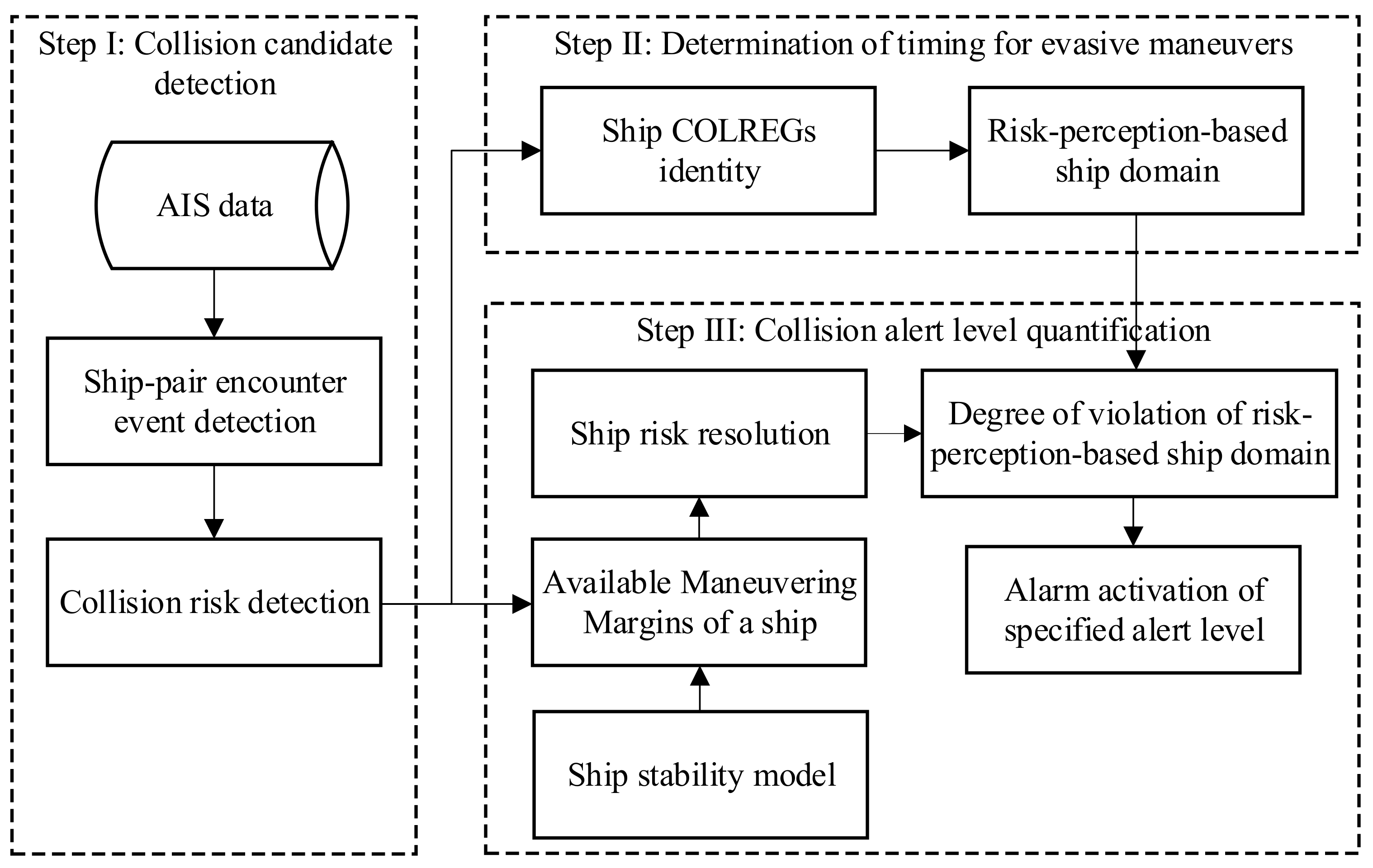

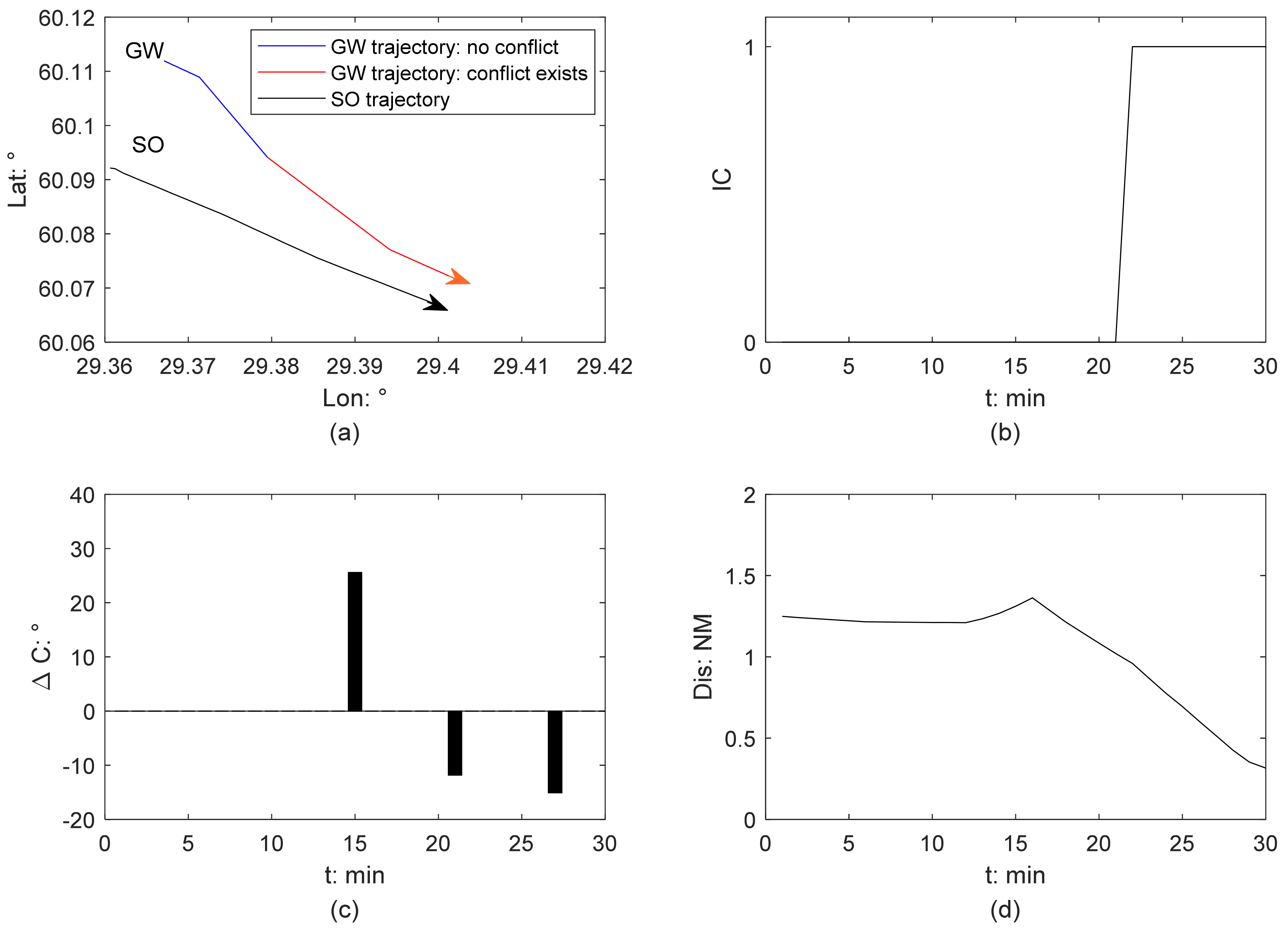
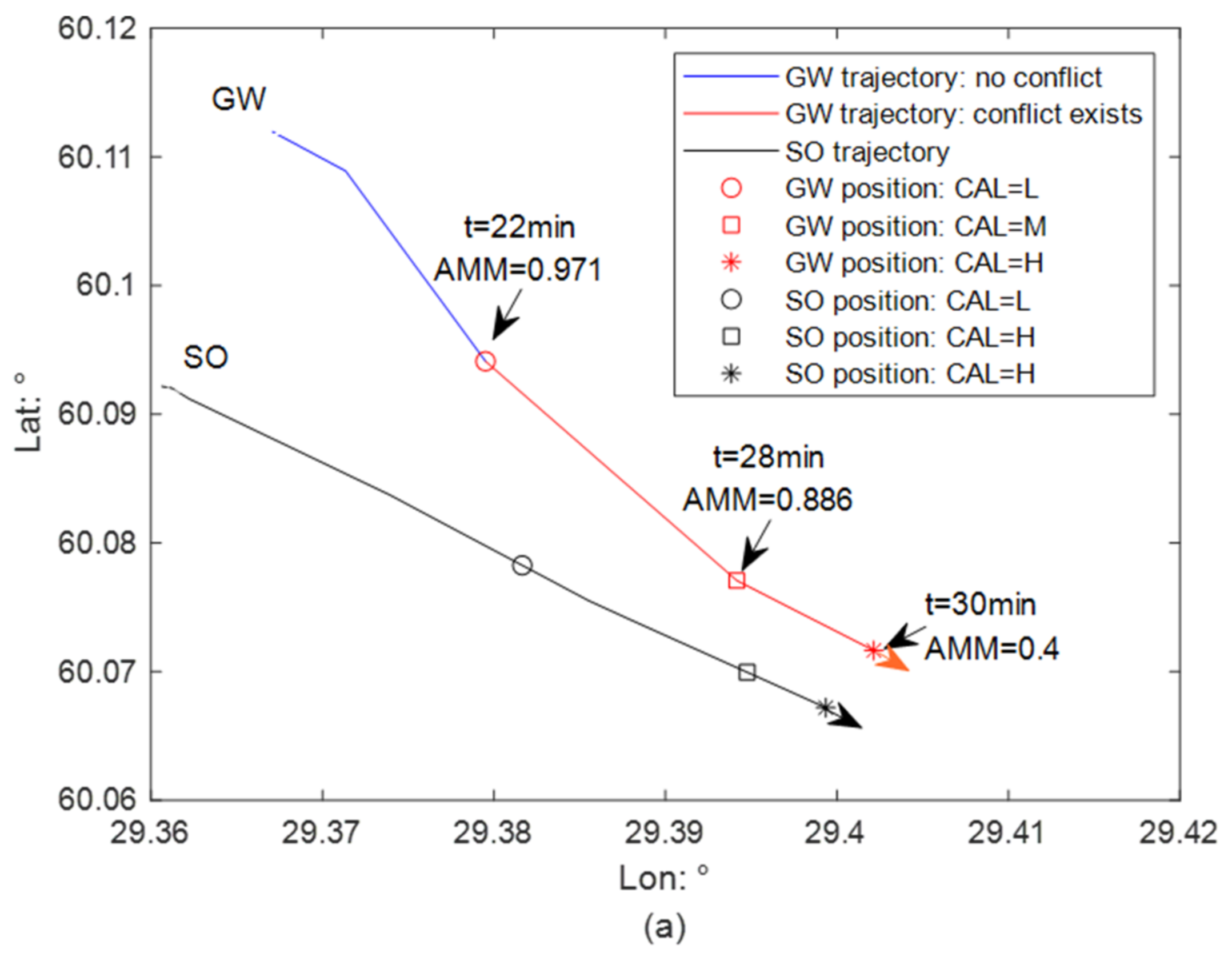


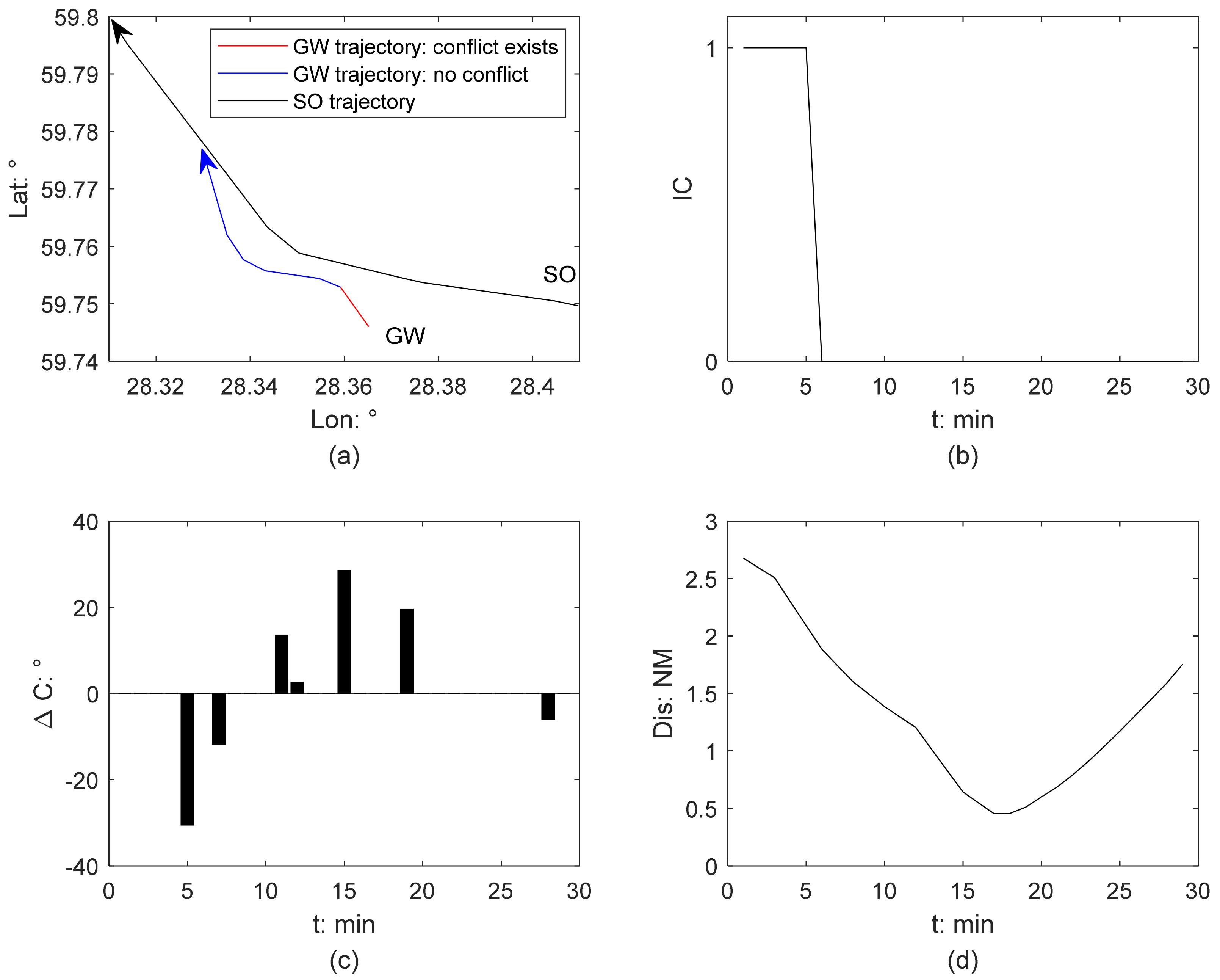
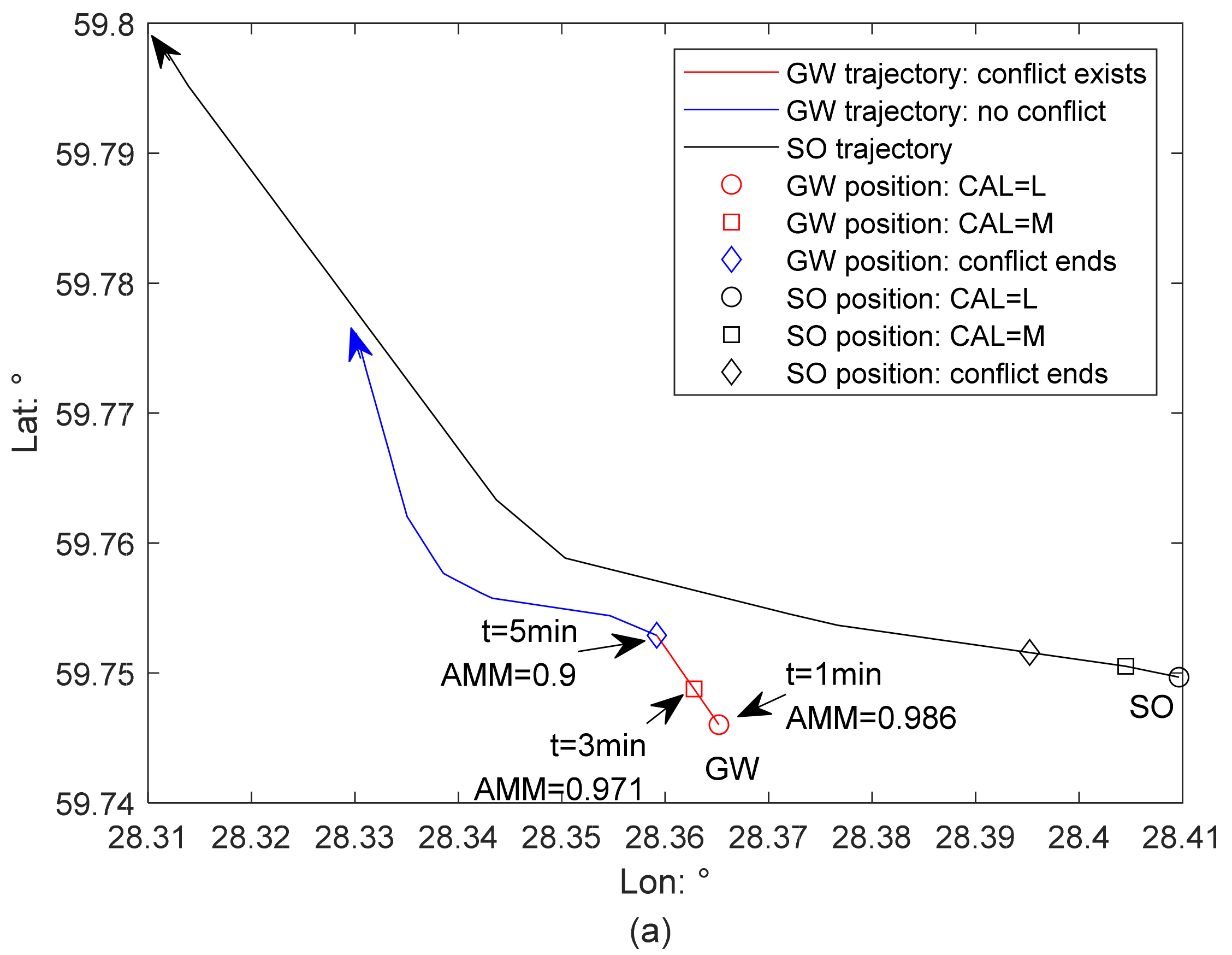
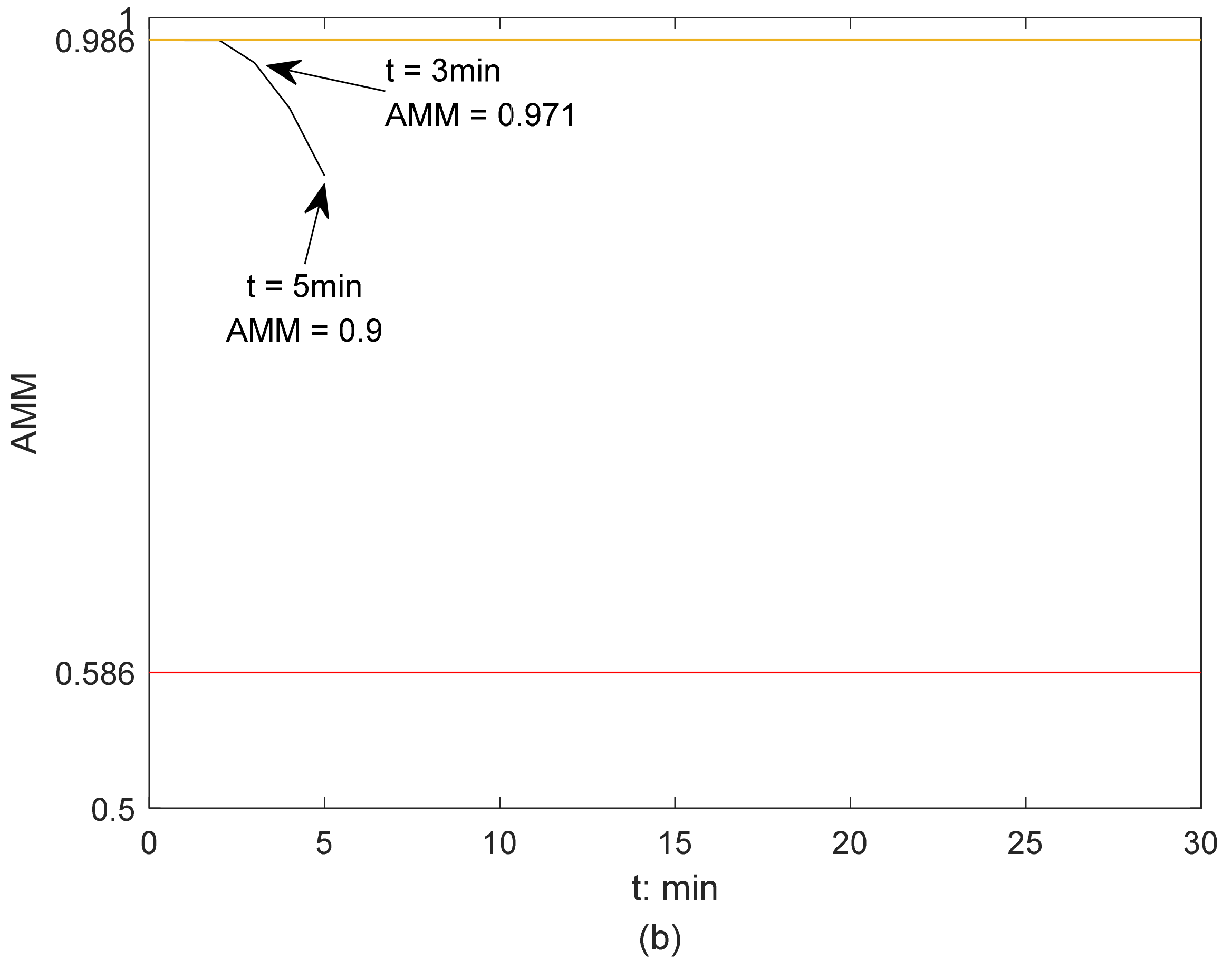
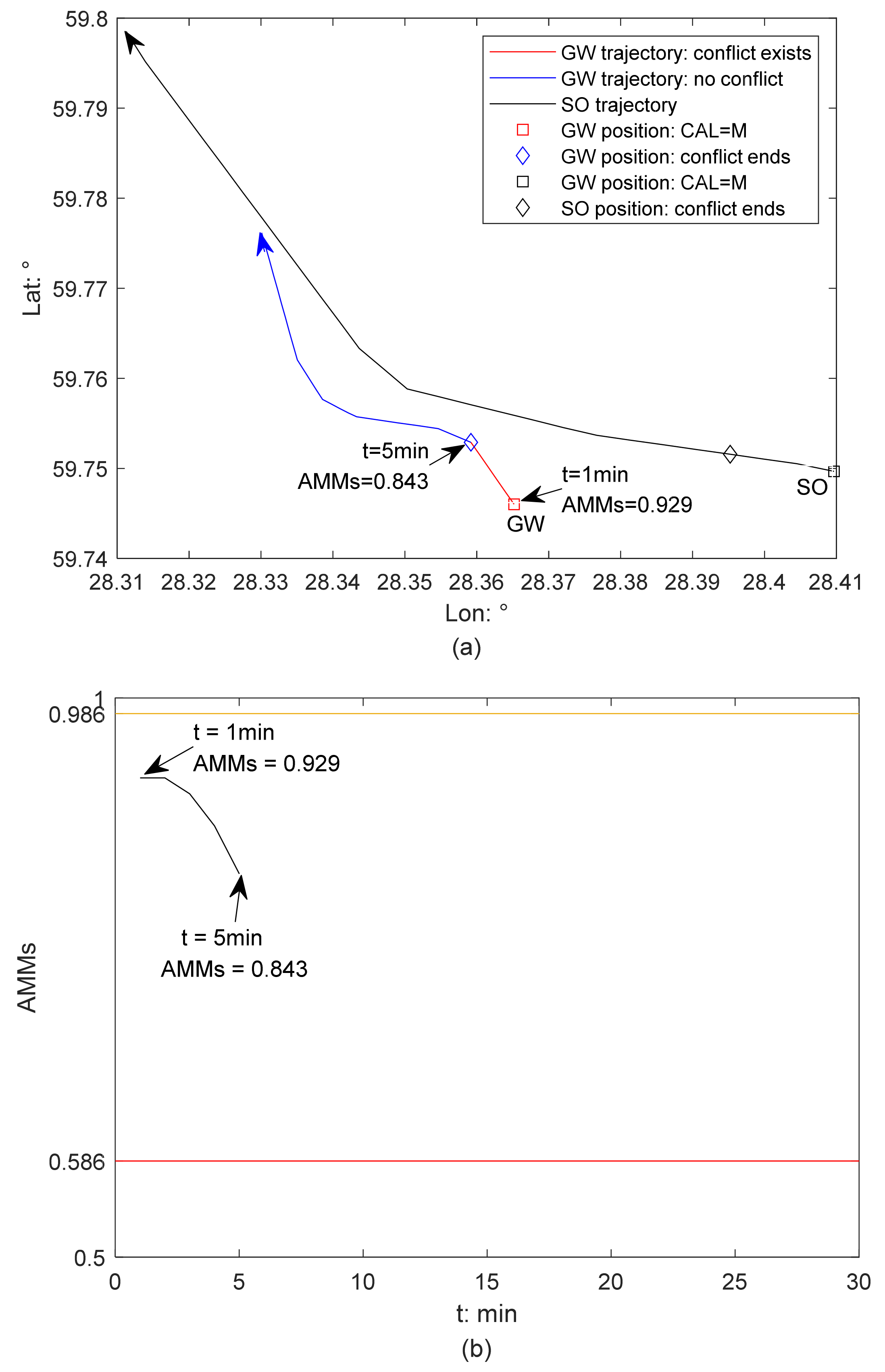
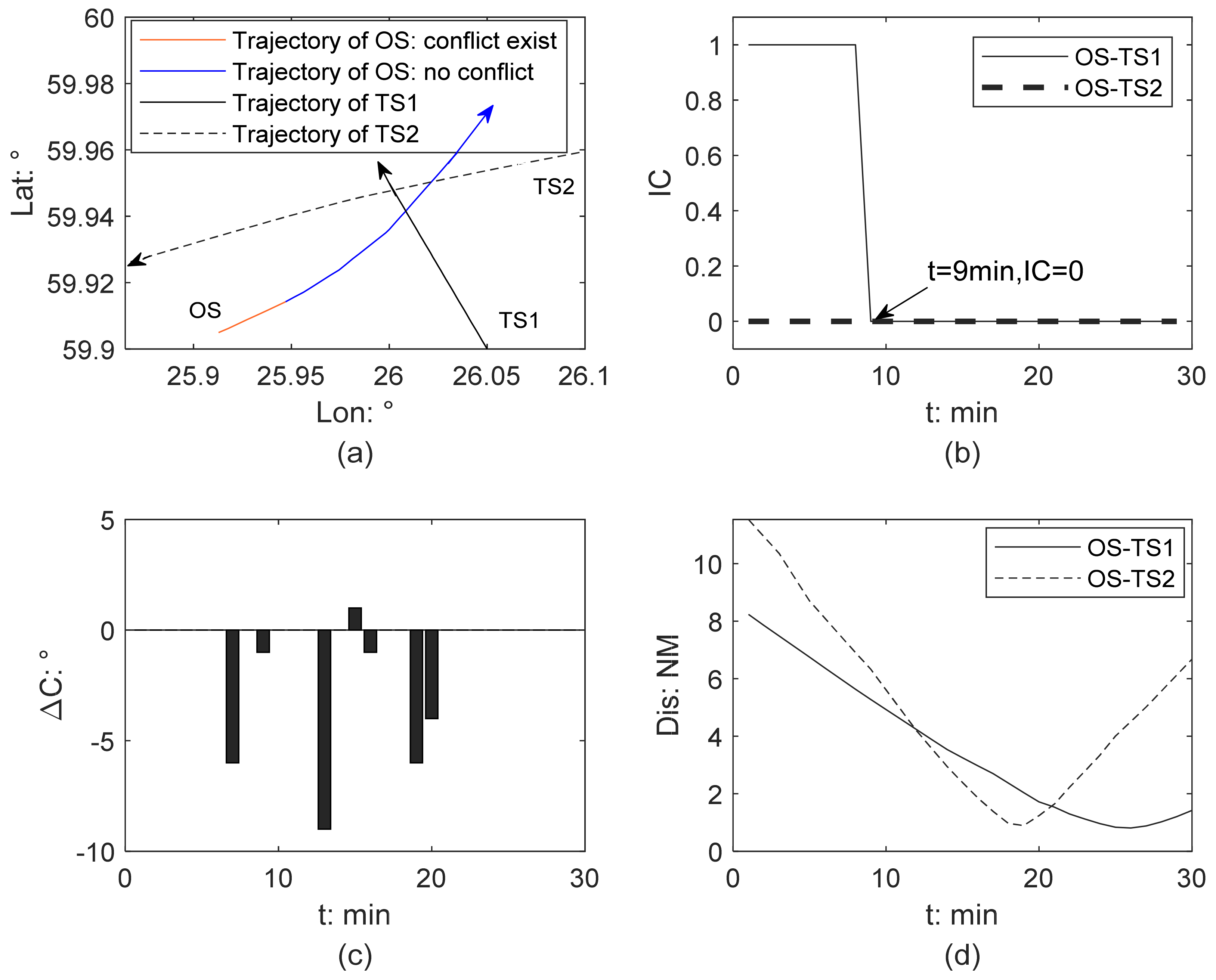
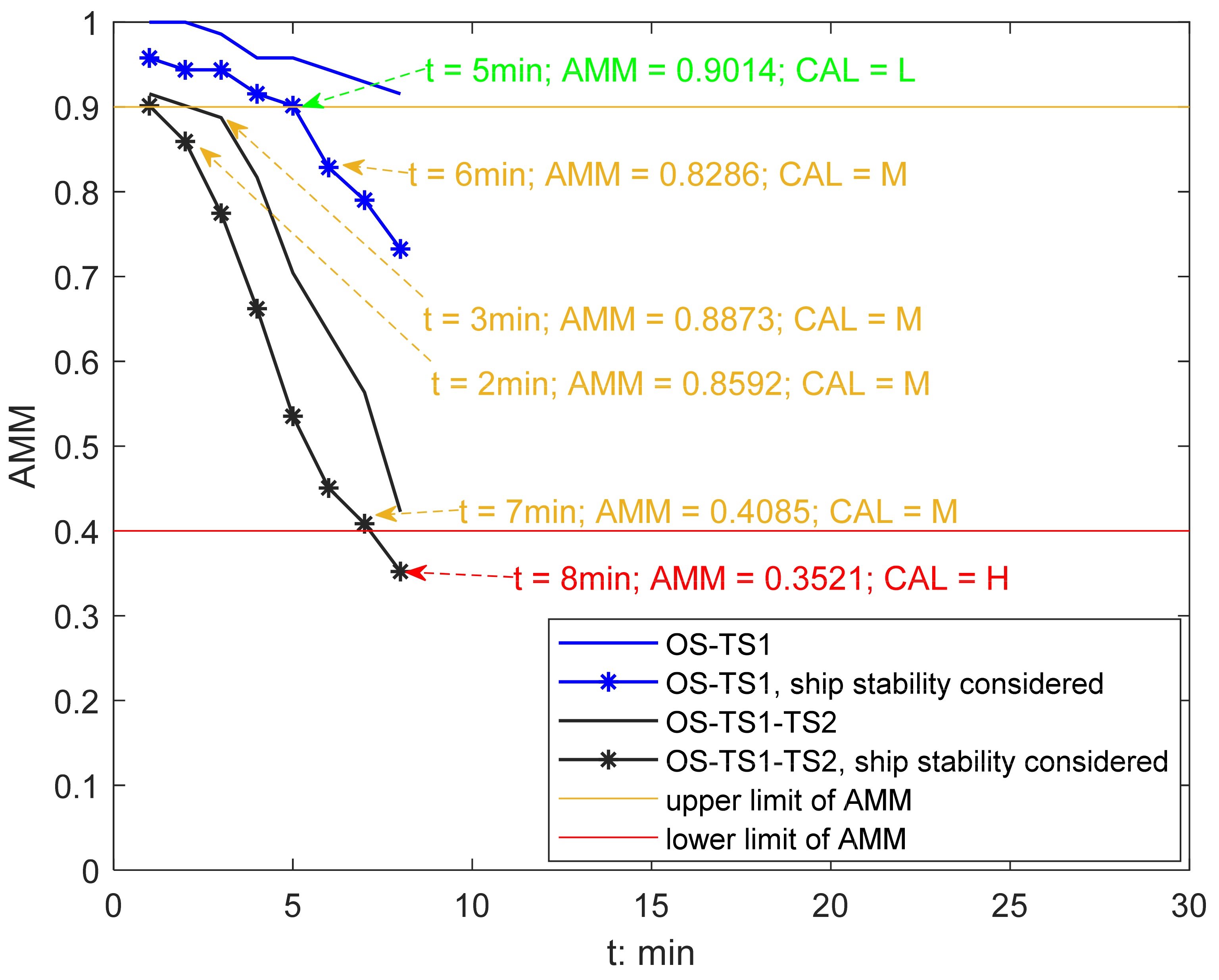
| Research Work | Risk Identification | Risk Level Quantification | ||
|---|---|---|---|---|
| Action Dynamics | Ship Resolution | Traffic Condition | Ship Stability | |
| Goerlandt et al., 2015 | + | + | − | − |
| Baldauf et al., 2017 | − | + | − | − |
| Cheng et al., 2020 | + | − | − | − |
| Du et al., 2020 | + | + | + | − |
| Szlapczynski and Szlapczynska, 2021 | + | − | + | − |
| Qin et al., 2021 | − | + | − | − |
| Ship Type | COLREGs Status | |||
|---|---|---|---|---|
| Small-Size | Medium-Size | Large-Size | ||
| Passenger Ship | GW | 0.986/0.586 | 0.914/0.486 | 0.814/0.343 |
| SO | 0.943/0.443 | 0.786/0.314 | 0.729/0.229 | |
| Tanker | GW | 0.871/0.471 | 0.829/0.314 | 0.8/0.229 |
| SO | 0.857/0.371 | 0.629/0.214 | 0.486/0.186 | |
| Cargo Ship | GW | 0.9/0.4 | 0.886/0.343 | 0.871/0.257 |
| SO | 0.729/0.314 | 0.5/0.243 | 0.486/0.157 | |
| Encounter Scenarios | Ship Identity | MMSI | Type | Length (m) | Width (m) |
|---|---|---|---|---|---|
| Scenario 1 | OS | 27335XXXX | Cargo ship | 84 | 15 |
| TS | 27343XXXX | Tanker | 126 | 16 | |
| Scenario 2 | OS | 27333XXXX | Passenger ship | 56 | 11 |
| TS | 20544XXXX | Cargo ship | 182 | 28 | |
| Scenario 3 | OS | 21352XXXX | Cargo ship | 92 | 18 |
| TS1 | 21107XXXX | Cargo ship | 110 | 14 | |
| TS2 | 26125XXXX | Cargo ship | 185 | 32 |
Publisher’s Note: MDPI stays neutral with regard to jurisdictional claims in published maps and institutional affiliations. |
© 2022 by the authors. Licensee MDPI, Basel, Switzerland. This article is an open access article distributed under the terms and conditions of the Creative Commons Attribution (CC BY) license (https://creativecommons.org/licenses/by/4.0/).
Share and Cite
Du, L.; Valdez Banda, O.A.; Sui, Z. Available-Maneuvering-Margins-Based Ship Collision Alert System. J. Mar. Sci. Eng. 2022, 10, 1123. https://doi.org/10.3390/jmse10081123
Du L, Valdez Banda OA, Sui Z. Available-Maneuvering-Margins-Based Ship Collision Alert System. Journal of Marine Science and Engineering. 2022; 10(8):1123. https://doi.org/10.3390/jmse10081123
Chicago/Turabian StyleDu, Lei, Osiris A. Valdez Banda, and Zhongyi Sui. 2022. "Available-Maneuvering-Margins-Based Ship Collision Alert System" Journal of Marine Science and Engineering 10, no. 8: 1123. https://doi.org/10.3390/jmse10081123
APA StyleDu, L., Valdez Banda, O. A., & Sui, Z. (2022). Available-Maneuvering-Margins-Based Ship Collision Alert System. Journal of Marine Science and Engineering, 10(8), 1123. https://doi.org/10.3390/jmse10081123








